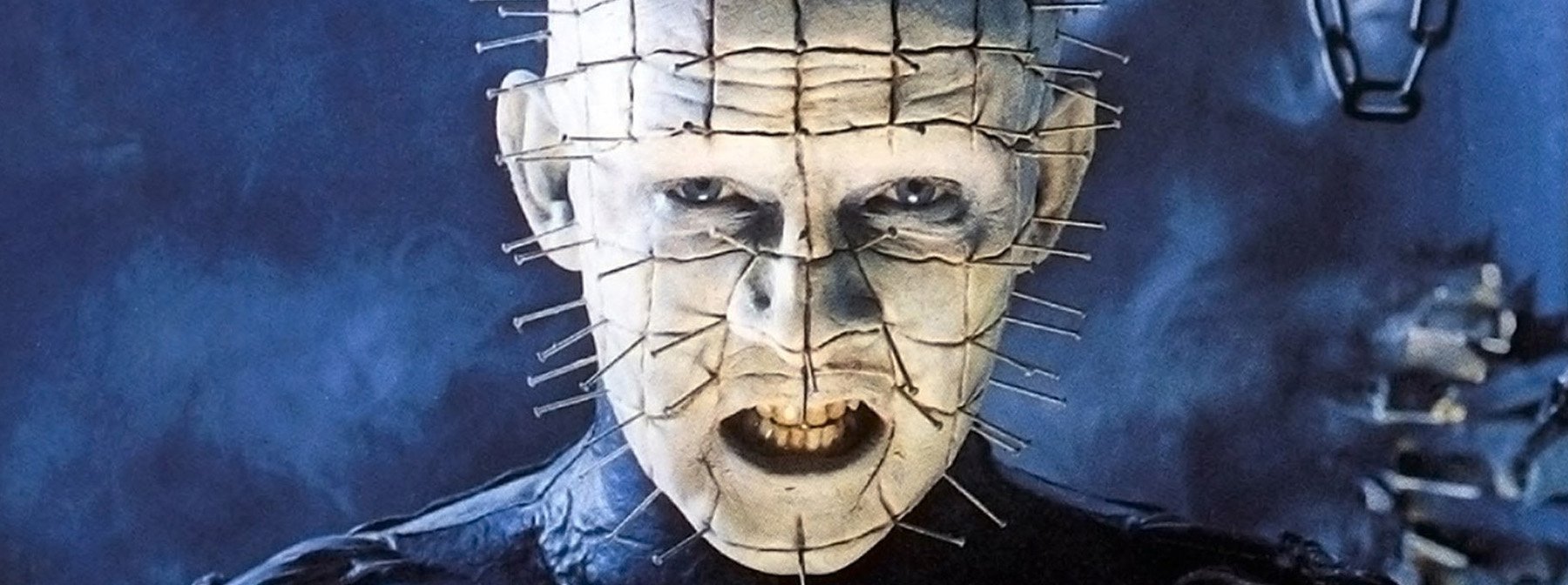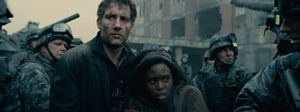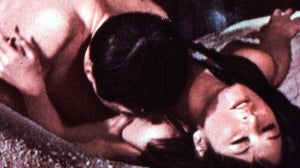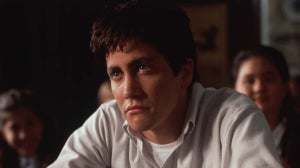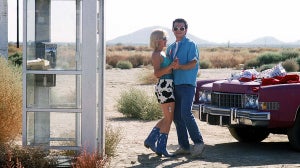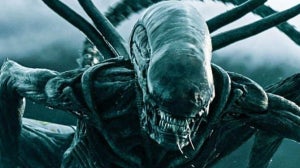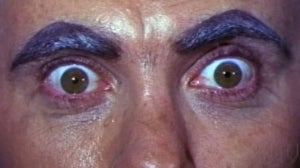
“I firmly believe that a story is only as good as the villain.” ― Clive Barker
It takes a morbid magician to deliver “such sights” on stage, page and the big screen. Prolific, sadistic, poetic, Clive Barker’s gothic romance and dark fantasies are a benchmark of horror fiction. His celluloid nightmares may not reach the heights of such an unrivalled imagination ― he so often demonstrates on paper and canvas ― but the films infect us all the same; a gateway drug to his grander schemes of unparalleled works such as Weaveworld (1987), The Great and Secret Show (1989), and Imajica (1991). Material ripe for blood streamed content.
On-screen ― the majority of adaptations based on short stories from The Books of Blood (1984-1985) ― Barker’s films, at their best, are less the throwaway can of beer and more a glass of wine served in a shattered carafe; a classy, mortifying taste that leaves its mark, inside and out. Let us tip the glass and raise some hell in celebration to the best of Barker on film…
10. Candyman: Farewell to the Flesh (1995)
Although this first sequel drowns subtext in blood and gore, it is by no means as bad as reviews would suggest. Set in New Orleans we explore a plot based around the descendants of the plantation slave (and gifted artist), Daniel Robitaille (Tony Todd) as we delve into a retelling of his tragic origin and the “forbidden” love that ultimately led to his torture.
Philip Glass returns for the score, but, with more screen time, it is Todd’s presence that lends the film any genuine weight and credibility. Directed by Bill Condon, whose next film would be the Oscar-winning Gods and Monsters (1998) ― in which Clive Barker served as executive producer ― he would also go on to direct a couple of Twilight (2011-2012) movies and Disney’s remake of Beauty and the Beast (2017). But we won’t hold that against him.
https://www.youtube.com/watch?v=Jm0tjau67Rs
9.Rawhead Rex (1986)
Having directed Barker’s first story for the screen ― Underworld (aka Transmutations, 1985) ― George Pavlou followed up with an obscure entry into the realms of Irish horror. With the original setting from Books of Blood: Volume Two (1984) moved from England to Ireland (for production purposes) the adaptation of Rawhead Rex is a schlockfest that only touches upon the potency of the original text of a Pagan god, raised from the dead and wreaking havoc across the Kent countryside. The source material devoured religion, xenophobia and even Freudian undertones but, alas, (as I’ve mentioned before) the film is “less Barker, more barking mad”. Instead of creating what could have been a rural rendition of Who Goes There? (1938), Pavlou bludgeons folk horror to death.
https://www.youtube.com/watch?v=3O9iBeqd4ig
8. Book of Blood (2009)
Building on the bookends from Barker’s original collection of shorts ― “The Book of Blood” (1984) and “On Jerusalem Street” (1985) ― John Harrison directs what is essentially a haunted house movie. Released the same year as Dread, adding The Midnight Meat Train to the watchlist makes for a solid Books of Blood triple bill. As independent features, both films still manage to deliver the shocks ― the revulsion of the meat-eating scene in Dread lifted right from the pages ― Book of Blood revealing some effective apparitions and face-tearing moments.
https://www.youtube.com/watch?v=deuIsmSsXPs
7. Hellbound: Hellraiser II (1988)
With its budget cut before filming commenced, the first Hellraiser sequel was never going to deliver on its vision of hell. In an attempt to move away from becoming pigeonholed as a filmmaker, Barker only helped with the story with no further credit than acting as an executive producer. Directed by Tony Randel ― producer and editor on the original ― the film is a more a high camp affair, with only fleeting (visceral) moments reminiscent of what had come before.
Although on screen for mere minutes in the first film, this time the Cenobites return to deliver more gore. In one of the best scenes, Pinhead’s origin is touched upon. Some would say by showing more of the Hell Priest, we fear him less but it only builds on the world; as much about the workmanship and intricate nature of the Lament Configuration than any of Barker’s infernal characters.
https://www.youtube.com/watch?v=rd427TjMGxI
6. Lord of Illusions (1995)
Barker’s third and final film as writer/director is a mixed bag. Some of this is down to decisions in altering the original material and, the original cut not living up to the horror most fans had become used to with his work. As with the majority of Barker’s writing and characterization, it often works better on the page, even when he is at the helm of one of his productions.
Ripe for a series, occult detective Harry D’Amour originally appeared in short story “The Last Illusion” from Books of Blood: Volume Six (1985), here played by Scott Bakula as he quantum leaps into Barker’s version of Philip Marlowe. D’Amour has gone on to navigate both hell and ‘The Art’. As movie canon, he was introduced to the world of the Cenobites in Boom! Studios’ Hellraiser comic book series (2011-2012) before Barker placed him as his lead in The Scarlet Gospels (2015); his sequel to the original Hellraiser novella, The Hellbound Heart (1986).
https://www.youtube.com/watch?v=lN1RToUAOQg
5. Nightbreed: Director’s Cut (2014)
Adapting his novel, Cabal (1988), Barker’s original theatrical cut of Nightbreed (1987) is a prime example of how his epic vision is often lost on screen. In this instance, the studio’s desire to shape and market it as a slasher only detracted from the strangely heroic but monstrous world. Both the Director’s Cut and Cabal Cut are more ‘complete’ versions; longer with an additional 40 minutes that places more emphasis on Midian’s mythology. Story mostly intact, the longer cut is not as different as you would expect, more cosmetically enhanced with a different ending. If you can track down the Cabal Cut, all three versions make for an interesting study of how a great mind unshackled can create a true work of art.
https://www.youtube.com/watch?v=gKXnT8FVleY
4. Candyman (2021)
Of all the recent sequels, remakes and reboots, Nia DaCosta’s extension of Barker’s urban legend is a more than prevalent piece of work. Co-written with Win Rosenfeld and Jordan Peele (who also served as producer), the urban legend is given an obvious shift in perspective with Universal horror placing black filmmakers front and centre.
Nothing is lost and everything is gained as the world is expanded on; most intricately displayed through the use of shadow puppetry during the film’s segments on racial injustice. Produced by the Emmy Award-winning company Manual Cinema, the striking use of silhouette ― implementing vintage projection techniques ― paints an eerie and disturbing portrait of a nation’s history. Not only that, but the sequences harken back to the earliest forms of moving image with a hint of Lotte Reiniger’s ‘overshadowed’ animated feature, The Adventures of Prince Achmed (1926) thrown in for good measure.
https://www.youtube.com/watch?v=tlwzuZ9kOQU
3. The Midnight Meat Train (2008)
Brought to the screen by Versus (2000) director Ryuhei Kitamura, this adaptation of the short story from Books of Blood: Volume One (1984) showcases a ‘heady’ mix of Asia Extreme and Barker’s sadomasochism. Vinnie Jones delivers another (silent) juggernaut performance as the ‘Subway Butcher’ as he is tracked down by photographer, Leon, played by Bradley Cooper, who would break out the following year in The Hangover. This is a frenzied work; the end results delivering an unapologetic ‘eye-popping’ tour of a city’s intestinal underbelly… and alternate highway to hell.
https://www.youtube.com/watch?v=wtUiRfMy_uI
2. Hellraiser (1987)
Based on his 1986 novella The Hellbound Heart, Barker’s directorial debut still remains a bold and disturbing vision; a perfect machine oiled in blood, every part as intricate as the next. Yet, the film’s visceral qualities lie in its grain and grit; its cynical edge that only a British filmmaker and environment could evoke. Of course, Pinhead (Doug Bradley) is an iconic villain; a fresh change after the staple masked killers had run their course and there are countless moments (and quotes) to highlight. But it is the morbid marriage of Bob Keen’s special makeup effects and Christopher Young’s powerful score that sells Frank’s horrific attic rebirth as a pure operatic masterpiece.
https://www.youtube.com/watch?v=8mOn4h0lgKQ
1. Candyman (1992)
There is more to reflecting on Bernard Rose’s adaptation of “The Forbidden” than saying the name of the eponymous villain five times. The mirror in Candyman isn’t just a cheap ‘hook’ but reveals the pain and suffering of an individual through the reshaping of ancient myths into both an urban legend and ― in context to the injustice and racial tensions of the period ― a powerful social commentary.
At its core, Barker’s story is an exploration of deep-rooted fears ― castration anxiety; emasculation and faceless entities ― primarily; “the experience of horror” [1]. In Barker’s story, the monster has become a rumour of something human, “… the writing on the wall, the whisper in the classroom.”
Beyond the politics, the mythic storytelling endures. Whether it is the power of Barker’s imagination; Roses’s craft as a filmmaker; Philip Glass’ eerily innocent, operatic (toy piano) score; Virginia Madsen’s hypnotic and enchanting performance or Tony Todd’s powerful presence… every component works perfectly. It is definitive of its creator(s) and these are the reasons why Candyman remains not only the best Barker on film but also one of the greatest horror movies ever made.
https://www.youtube.com/watch?v=SXdbIOptIlM
[1] Stokes, P., Stokes, S., ‘Say His Name…’, Clive Barker Archive, 5 September 2021, https://www.rollingstone.com/movies/movie-news/boogeyman-nights-the-story-behind-this-years-horror-hit-the-babadook-49141 (accessed 15 April 2022)

